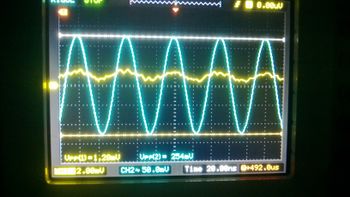Physics of Semiconductor Devices
One goal of the Carrier Dynamics in a Semiconductor Device project is to measure captured carriers within the band-gap of a semiconductor. If a carrier (a hole or electron) is captured and then released in the band, the capture center is called a trap. These traps arise from defects or impurities in the material. One technique for measuring these traps is through Deep Level Transient Spectroscopy, or DLTS. This technique essentially measures the change in capacitance of the semiconductor.
A semiconductor is usually formed from two different types of materials, one which will be highly doped with holes i.e. p t-type(or an atom that can easily accept an electron) and doped with electrons i.e. n-type(atom that can easily give an electron). When these two materials make contact, there is an imbalance of charge that want to return to equilibrium. In doing so, some of the electrons from the n-type diffuse into the p-type, combing with some of the holes. The same goes for the other side. When this process stops, we have what is called a depletion layer, or potential barrier. This barrier represents the electric potential that is needed to overcome if any current is to get through. When reverse-biasing the semiconductor, the p side is made more negative from electrons flowing in, causing the potential barrier to increase. When it is forward biased, the p side becomes less negative, thus decreasing the potential barrier to the point where current can flow through.
During these forward and reverse-biased pulses, there will be a change in the electron occupation of a trap from the steady state value, Because capacitance is a measure of charge, a change in the electron occupation will create a change in the capacitance.
Because the capacitance decays back to equilibrium quickly, we need a circuit that is capable of making measurements very fast. This can be done by using fast-recovery diodes, typically around 40 nanoseconds. We must place the diode sample in a two-legged circuit. The first leg will have the reverse-biased diode. The second leg will have a 180* transformer with an attenuation network. This will phase shift the incoming rf signal to where only a very small current will flow through. When a bias pulse from a generator is sent through, we will see a small change in the diodes impedance. This small impedance change will then create a small change in the rf signal, which can then be amplified and sent to a lock-in-amplifier for observation.
Here we see a recovery time on the order of 40 nanoseconds.
We have a power drop of nearly -130 db, essentially zero.
This technique requires the use of delicate equipment, which must be protected from any surges. This is achieved by using two sets of crossed diodes and a quarter-wave transmission line. The first set is placed between the pulse generator and the rf signal generator. This pair of crossed diodes acts as a high series impedance in between pulses, and shows a low impedance during pulses. This protects the rest of the circuit from any noise. Right before the amplifier, the signal will go through a quarter-wave transmission line. A quarter-wave transmitter is mainly used to match impedances, but here we will be using it to achieve infinite impedance. This is done because the transformer acts according to
Remember that diodes posses the property of having roughly a voltage drop of 0.6 volts. This means that we need at least this much voltage to get any significant amount of current through the diode. The quarter-wave transformer coupled with the shunt crossed diodes can now exhibit an infinite impedance. During pulses the current will go through the shunt diodes to ground, acting as a short. need another pair of crossed diodes, this time shunted to ground.
In the above section we discussed the properties of semiconductors. We can now measure certain properties of the semiconductor by analyzing the change of capacitance under applied bias. Let’s first arm ourselves with the necessary equations for measuring the change in capacitance. As discussed earlier, a depletion region is formed from the different work functions of metal and semiconductors. Due to this band bending, a region in the semiconductor has been emptied of charge carriers. The resulting net charge is considered the depletion region. This width w, is characterized by,
w=√(2*e/q*n)(Vbi-(kbT/q)-V))
The capacitance of a diode can be determined by considering the depletion region as a dielectric of width w separating the metal contact area A from the semiconductor
C=(e*A)/w
Substituting these we get a measurement of the capacitance and how it varies with an applied bias.
C=A√((e*q*n)/2(Vbi-(kbT/q)-V))
• e is dielectric constant of the semiconductor • n is the free electron concentration in the semiconductor
DLTS uses a changing bias to fill and empty charge traps to examine the traps over a given depth in the semiconductor. The sample must initially be under steady-state reverse bias in order for the electrons to remain in the conduction band. After the pulse, the traps in the depletion region empty, returning to this steady-state. This process is called electron-emission. When the bias voltage is pulsed to a higher V0, the traps become exponentially filled with electrons from the conduction band. The capacitance is then affected by the trapped charge. A decrease in trapped charge causes an increase in capacitance. This rate is related to the emission rate through the relation,
en(T,ET,σ c)= γn*σ c*T2*e^-((Ec-ET)/kbT)
γn is a set of constants we will not be concerned with now.
The capacitance transient is expressed by:
C=C0√1-(nT(t)/n)
The final DLTS signal will consist of the change in capacitance,
δC=C(t1)-C(t2)
by the final capacitance, C0 to give:
S=(δC/C0)= [1-(ω20/ω2b)]*(nT/2n)*[e-en(T)t1-e-en(T)t2]
where ω0 and ωb are the widths of the depletion region under zero and reverse bias respectively
The first sample gave the following results:
We can see that the circuit output is from the sample alone. We can now move to the Schottky Diode samples made in the lab.
![{\displaystyle n1=[e2/e1+e2]N}](https://wikimedia.org/api/rest_v1/media/math/render/svg/bf38570612ac30677f075df94792b58226b01eb5)


